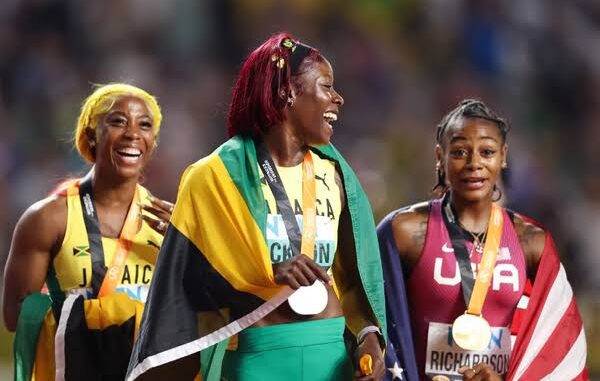
With the 2025 World Championships approaching, the women’s 100m is shaping up to be one of the most competitive sprint events in recent history.
The field is loaded with depth, from established champions to rising stars, and the question on many fans’ minds is whether Sha’Carri Richardson can carve a path to a podium finish. The answer, while not straightforward, is rooted in a mix of current form, competition analysis, and strategic race execution.
Sha’Carri’s potential has never been in doubt. Since bursting onto the scene with her flamboyant personality and blazing top-end speed, she has maintained a reputation as one of the most dangerous sprinters in the world when in form.
Her 2023 World Championship gold in Budapest proved she can deliver on the sport’s biggest stage. However, two years is a long time in elite sprinting, and the landscape has shifted. The 2025 season has brought new challengers, faster times, and an even more unforgiving qualification process.
To earn a medal in Tokyo, Richardson will need to navigate a field that could include defending Olympic champion Julien Alfred, the ever-consistent Shericka Jackson, and the resurgent Elaine Thompson-Herah, not to mention rising talents like Tamari Davis and Julien Alfred’s Saint Lucian teammate, Kenisha Antoine.
All of these athletes have sub-10.9 credentials and the ability to deliver under pressure. Against this backdrop, Sha’Carri’s path depends on three key factors: her start, her ability to maintain top speed under fatigue, and her championship mindset.
Historically, Richardson’s acceleration phase has been her Achilles’ heel. While her top-end speed is elite, she has sometimes given up too much ground in the first 30 meters, forcing her into a late-race surge. In a championship final, where margins are razor-thin, this can be the difference between gold and bronze—or missing the podium entirely. The key for 2025 will be refining her reaction time and drive phase, making her competitive from the gun rather than relying solely on closing speed.
Another critical factor is consistency. The 2025 Diamond League circuit has shown flashes of Richardson’s brilliance, but also periods of uneven performance.
Medaling at the World Championships requires stringing together peak races across heats, semifinals, and the final within a tight schedule. That demands not only physical sharpness but also mental resilience—an area in which Richardson has both improved and been tested since her early career setbacks.
The good news for Richardson is that she has proven she can peak when it matters most. Her tactical execution in Budapest, where she ran a then-personal best from lane nine, showcased her ability to remain composed under high stakes. If she can arrive in Tokyo healthy, sharpen her first 40 meters, and manage the psychological demands of back-to-back rounds, she will be in medal contention.
Ultimately, Richardson’s path to a medal is challenging but very real. She will need to execute her best race of the season on the night it matters most, and against a field where a single misstep can cost a place on the podium.
Yet history has shown that underestimating Sha’Carri is a mistake. If she brings her trademark finish, couples it with a competitive start, and embraces the moment, the 2025 World Championships could once again see her standing among the fastest women on the planet.
Be the first to comment